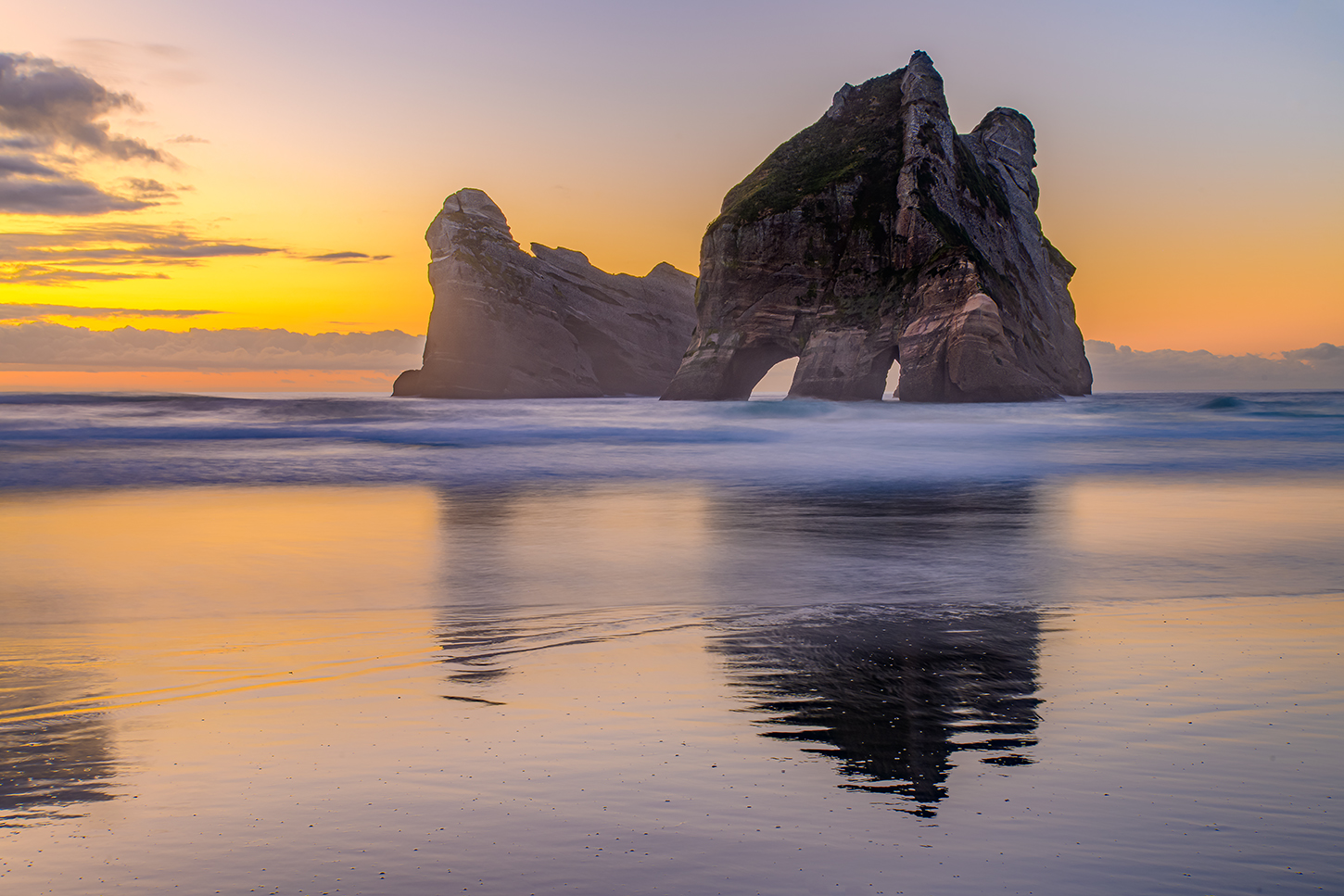
New Zealand, the country at the other end of the world, is not something you travel to every day. For many people, the country is a “once in a lifetime” dream destination and a photography trip should be well planned accordingly.
Christian Heeb, book author and long-time New Zealand expert, describes his favorite locations:
In my opinion, the best times to travel are March, April to mid-May and mid-October, November to mid-December. Towards the middle to end of April, there are beautiful autumn colors in the southern Alps of Otago. In November, the mountain ranges usually have white peaks. Christmas and New Year should be avoided. January and February are holiday months with overcrowded campsites and are rather boring for landscape photographers.
– An optimal route starts either in Auckland (North Island) or in Christchurch (South Island). It is a “one-way” tour with a rental car and hotel overnight stays or camper van. The ferry between the North and South Islands can be pre-booked through the car rental company. A one-way trip has the advantage that you can visit most of the photogenic places on the islands without having to circle back. One way rentals are common in New Zealand.
Our trip takes place in autumn, and so we start in the ‘colder’ south of New Zealand.
1. Akaroa
The beautiful town on the Banks Peninsula near Christchurch, has retained its old charm. The historic houses in French and British colonial style are very photogenic. If you like it tranquil, you can get a taste of New Zealand here. The town has good restaurants and a lovely holiday atmosphere. There is also a small lighthouse.
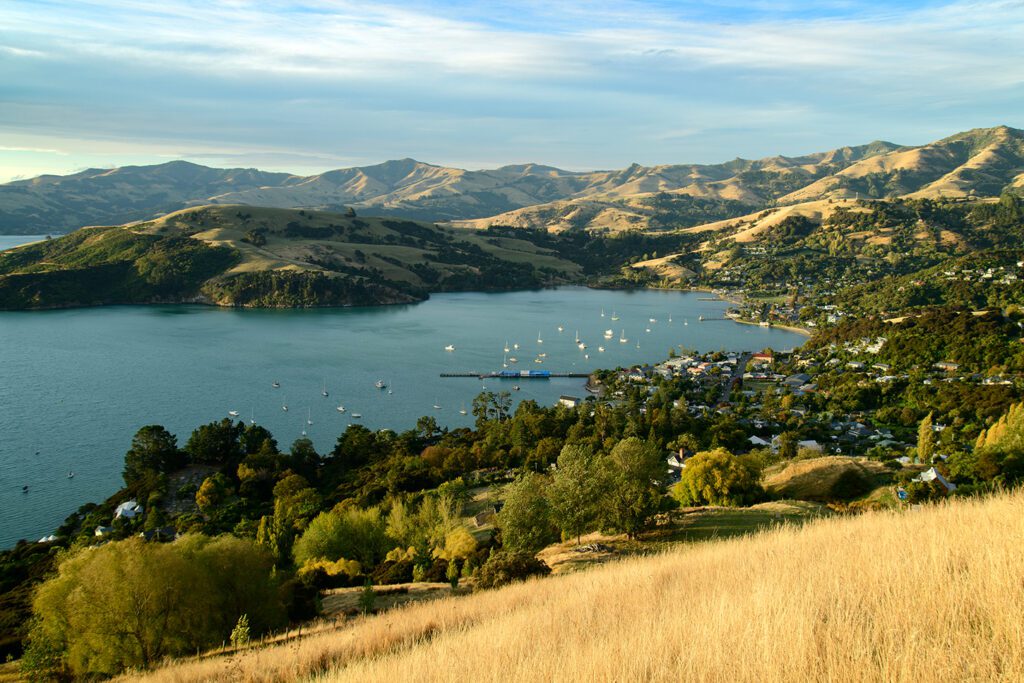
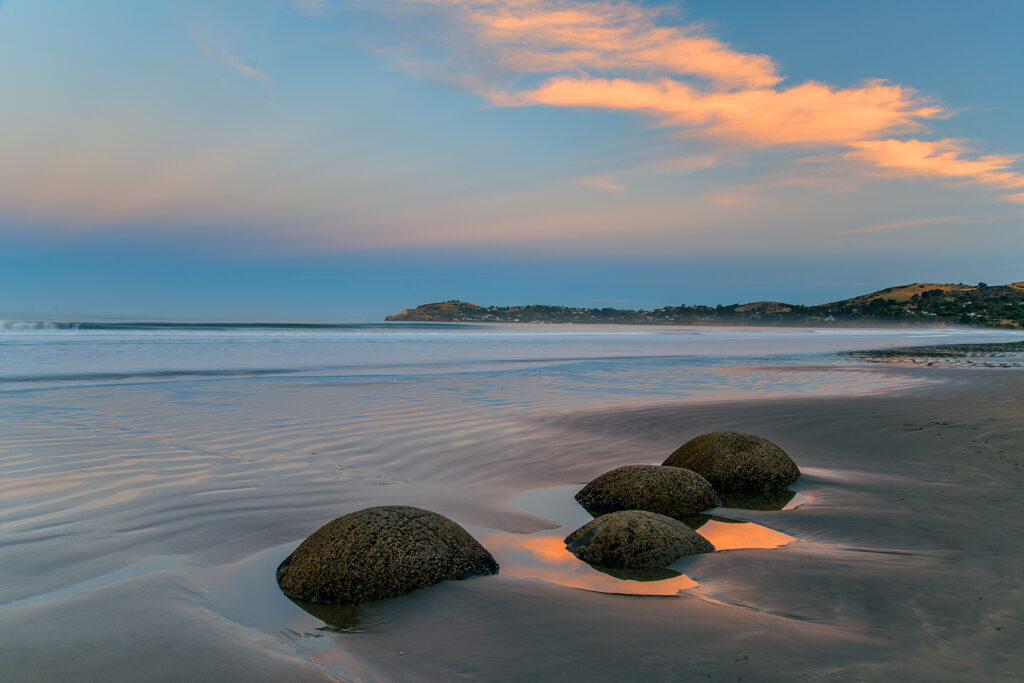
2. Moeraki Boulders
South of Oamaru on the East Coast are the Moeraki Boulders, large rock balls on the beach of
Koekohe. The rocks washed by the waves of the Otago coast are a popular photographer’s hotspot. A little south is the Katiki Point lighthouse. With a little luck, you can see yellow-eyed penguins there in the late afternoon. The colonial town of Oamaru, whose Victorian townscape is very photogenic, can be used as a good starting point for the Moeraki Boulders.
3. Dunedin
If you follow the coast south, you will inevitably come to Dunedin, the Scottish-influenced city, full of Victorian and Edwardian architecture. Dunedin’s urbanity offers a great contrast to the natural landscapes of the East Coast. At nearby Tunnel Beach, south of the city, there is a beautiful stone arch and steep rocky cliffs.
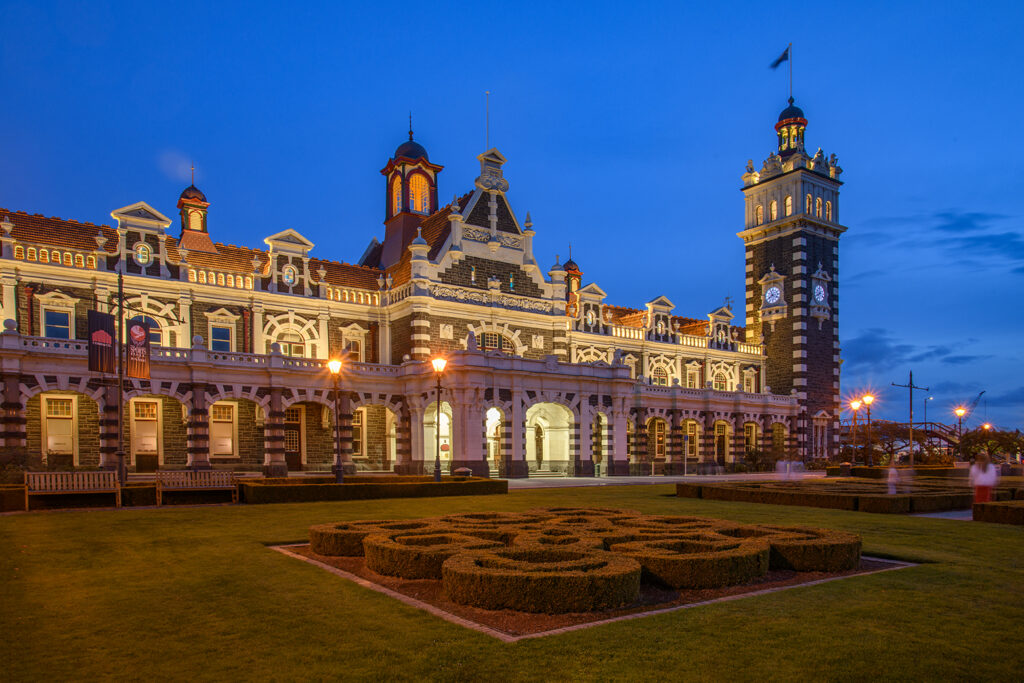
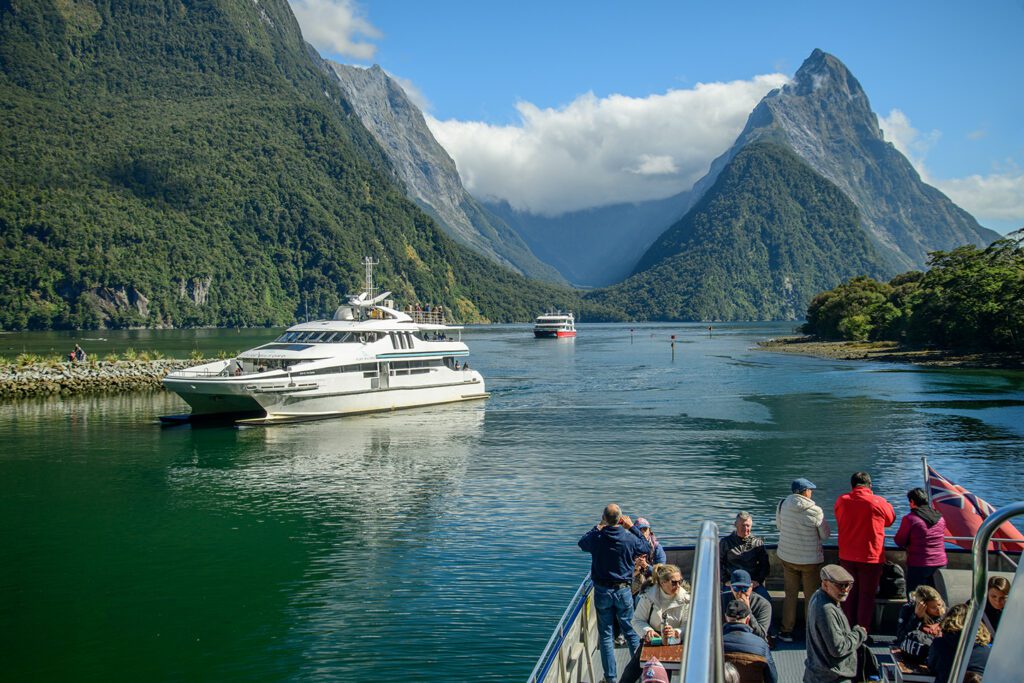
4. Milford Sound
From Dunedin, the journey goes to TeAnau and thus already to the edge of the fjord country. The town, located on a beautiful lake, is a good place to visit Milford Sound, New Zealand’s greatest natural attraction. It is best to stay there for at least two days and take a trip to the nearby park. The road, which leads through dense temperate rainforest full of moss and fern trees, is worth the trip in itself. The landscapes are particularly dramatic in the rain, when waterfalls cascade from the high cliffs into the valley. Because of the large number of tourists, you should book the excursion boat in advance. It is best to book the tour at 1 o’clock and take your time on the drive to the park to take photos.
Alternatively, you can book the Doubtful Sound excursion from TeAnau and avoid the crowds of tourists.
5.Wanaka
Once you have had enough of the greenery of the Fiordland National Park and the boat trip through Milford Sound, the journey continues north. If you like crowds and commercialized adventure sports, you can spend a day in Queenstown. But we go straight to the somewhat quieter town of Wanaka, which is also experiencing a boom. The legendary Wanaka Tree, a willow tree standing in the water that is crowded with photographers, has been trimmed by vandals and has lost some of its appeal. The nearby mountains and the many hiking trails are still a reason to stay here. There is also excellent coffee and good restaurants in the town. In mid to late April, there are already beautiful autumn colors to be found. Follow the lake towards the mountains, where there are beautiful bays and poplar trees.
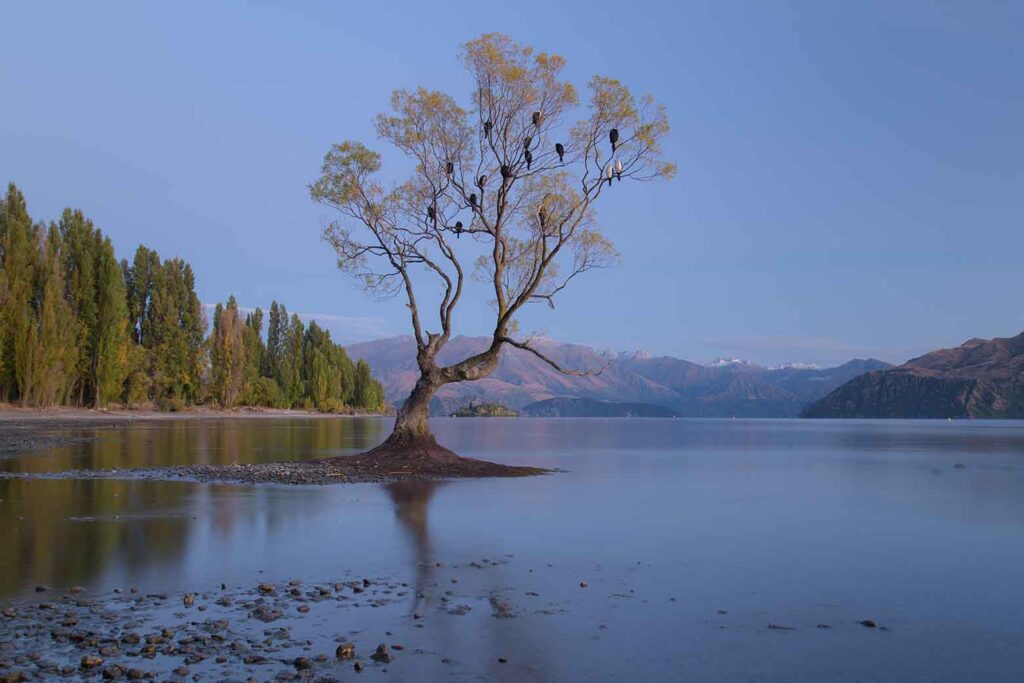
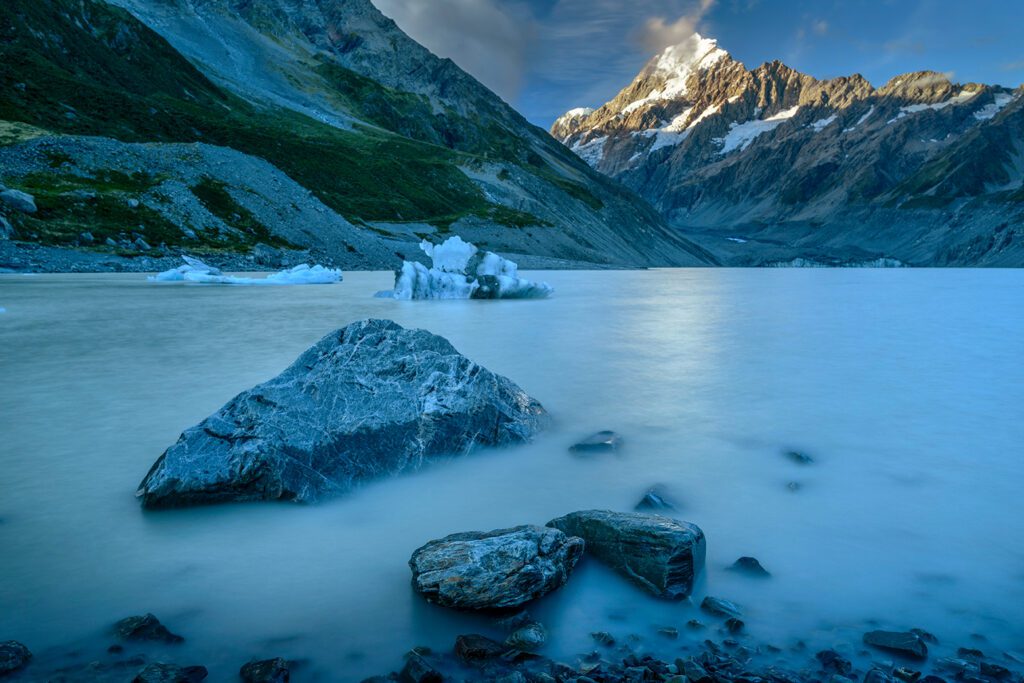
6. Mount Cook
Mount Cook National Park, north of Wanaka, is another great hiking spot. The road leads photogenically along Lake Pukaki to the town of Mount Cook, the visitor center in the park, where there is also accommodation. A hike to Hooker Lake, behind which the icy masses of Mount Cook tower, is not to be missed. On the drive from Wanaka to Mount Cook, you should do the little detour to the Clay Cliffs near Omarama.
7. West Coast Lake Matheson, Fox Glacier
From Mount Cook, you go back to Wanaka, or directly to the West Coast town of Fox. Via Haast Pass, from which you can get from the dry landscape in Otago to the lee of the damp, windswept landscapes of the West Coast. The small tourist town of Fox is the starting point for the nearby Lake Matheson, where you can take wonderful photos of the mountains, Mount Cook and Mount Tasman, reflected in the still water.
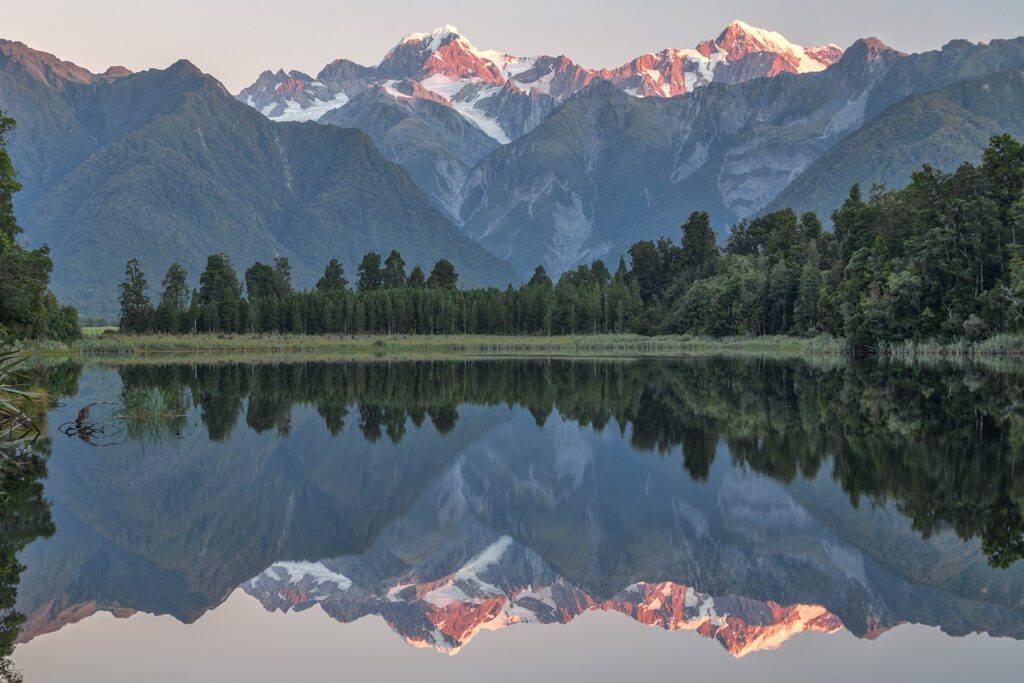

8. Greymouth
Highway 6 follows the west coast north to Westport. Various small towns, such as the pretty town of Hokitika, invite you to take a quick look around. The Pancake Rocks on the Paparoa Coast, a stretch of coast full of eroded rock slabs, is a good place to stop. The area here is very photogenic and is teeming with rocks standing in the sea. The layered rocks there look like pancakes, hence the name. Further north at Cape Foulwind west of Greymouth there are large, polished pebbles on the beach. At low tide you can find bizarre rock slabs and Rolling Stones that can be put in the right light very photogenically. There are a few hotel rooms at the Pancake Rocks and several good motels in Westport.
9.Takaka Wharariki Beach
Highway 7 now leads from Greymouth to the northeast, towards Nelson. Our destination is the town of Takaka, in the northwest of the island. The town, which lies behind mountains, is the starting point for Wharariki Beach, a long stretch of beach where large rocks, including a stone arch, stand in the sea. The town itself is surrounded by idyllic agricultural landscapes and small natural oasis. Because of the great distances, you should spend at least two days here. Takaka is reminiscent of Hawaii’s Hawaiian island and has an alternative hippie flair.
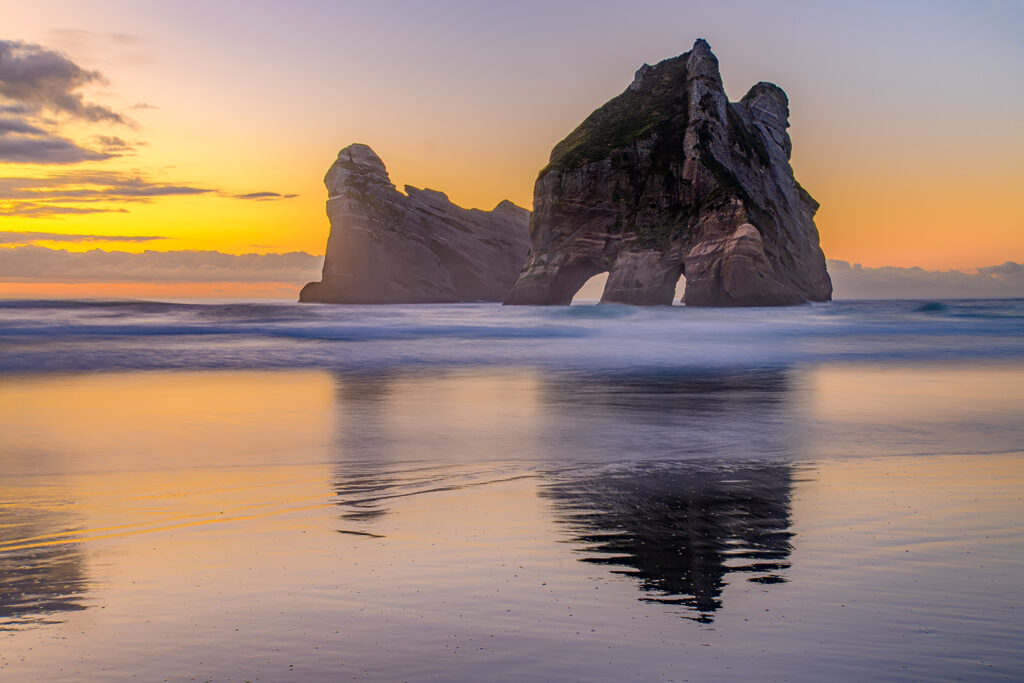
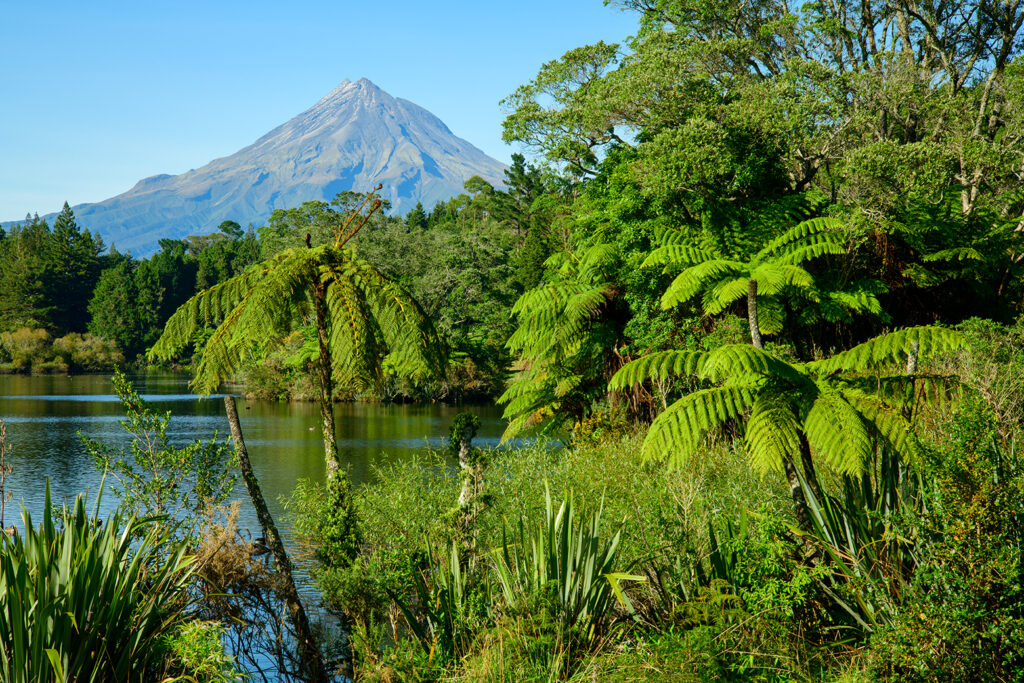
10. Egmont National Park
From Takaka we head to the North Island, past Nelson, to Picton, where the car and passenger ferry departs for Wellington. Wellington, the capital of New Zealand, is worth a stay, but for our purposes in terms of natural landscapes, we only plan to stay overnight.
We drive on to Egmont National Park. Mount Taranaki is a volcano as you would imagine it. A perfect snow-covered cone. On the flanks, beautiful waterfalls cascade down steep cliffs between moss-covered trees. It is somewhat shocking to realise how beautiful and natural the islands once were, before huge areas of natural vegetation were cleared and converted into cow and sheep pastures.
11. White Cliffs, Three Sisters Rocks
Just north of New Plymouth are the White Cliffs and the Three Sisters Rocks, which are only accessible at low tide. The photogenic coast is reminiscent of the south of England. The Paritutu Rock, just south of New Plymouth, offers good photo opportunities at sunset. Thousands of starlings nest there and put on a flying spectacle at sunset.
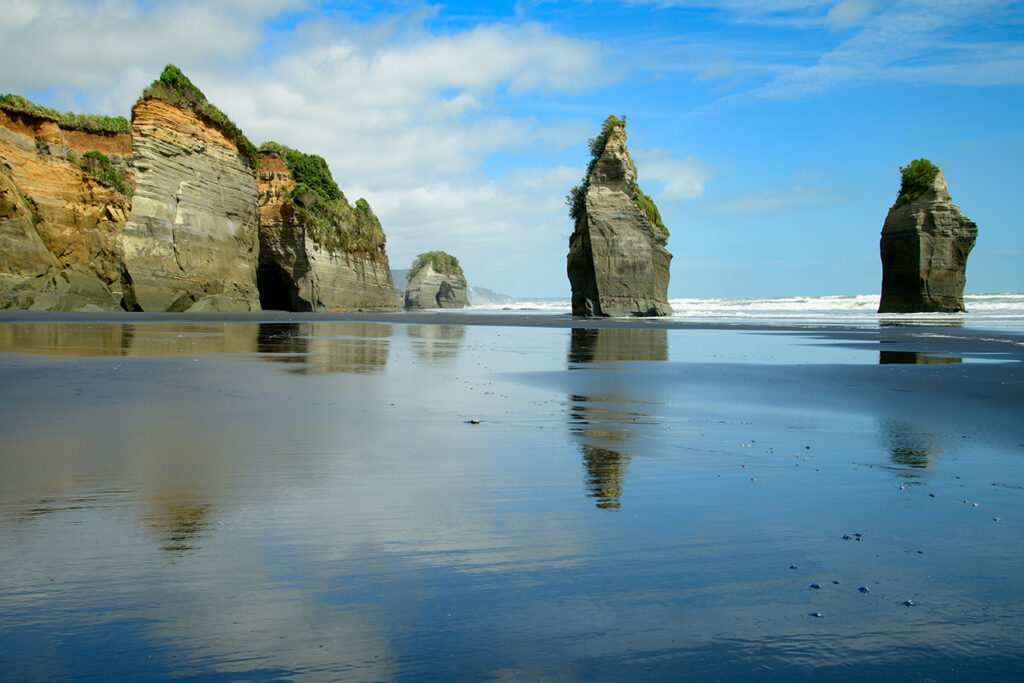
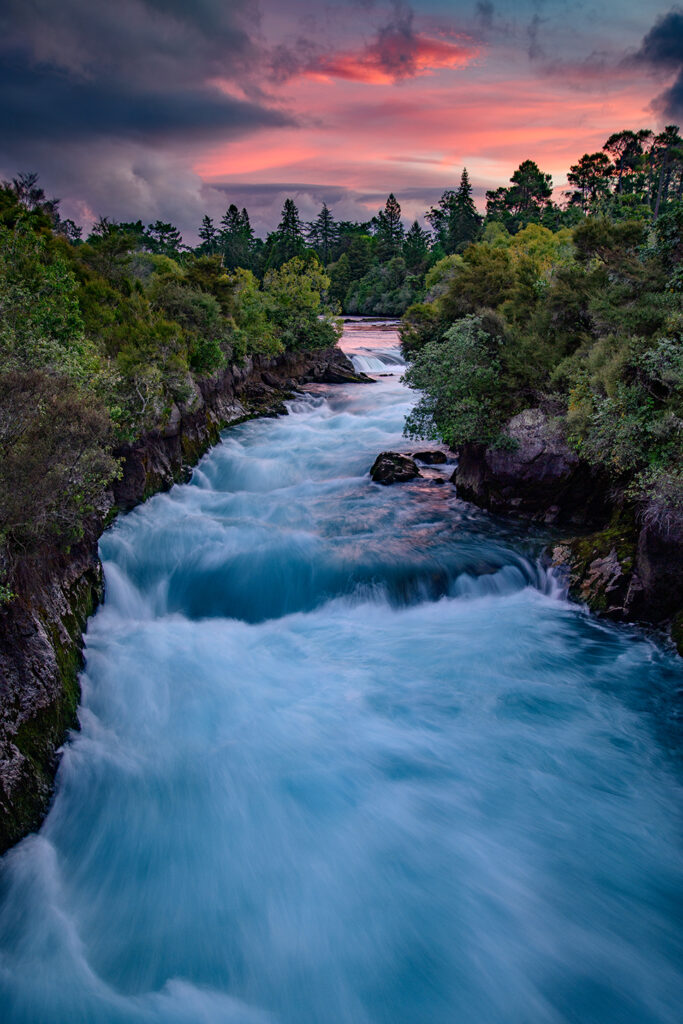
12. Taupo and Rotorua
The small town of Taupo, beautifully situated on the lake of the same name, is the starting point for thermal pools, volcanic hiking trails and rafting on the Okere River. In Rotorua there are opportunities to familiarize yourself with Maori culture. The Huka Falls in Taupo are a good place for sunset. In Rotorua there are several themed areas that charge admission. The area in Kuirau Park in the middle of the city is free.
13. Tarawera River
The Tarawera Falls in the Lake Tarawera Scenic Reserve east of Rotorua give an impression of the natural wild beauty of New Zealand. Dense rainforest and turquoise waters seem almost magical in a natural landscape populated by tree ferns. On my last visit, the area was only accessible on weekends. You have to obtain a permit in advance.
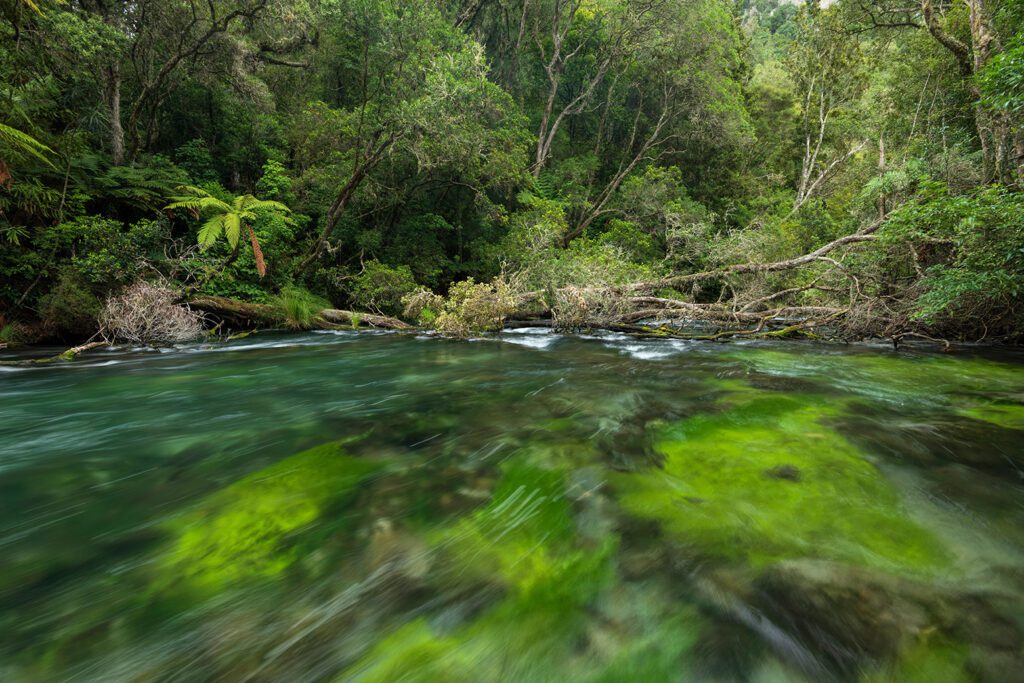
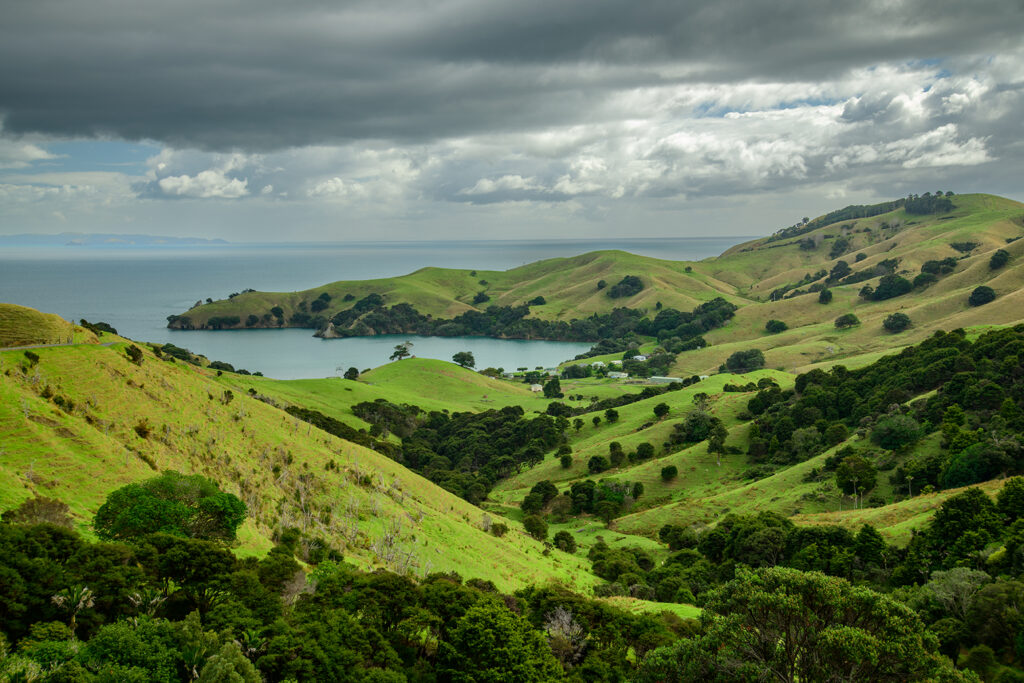
14. Cathedral Cove, Coromandel
The Coromandel Peninsula offers many beautiful beaches and a particularly exciting bay, including a large stone bridge called Cathedral Cove, which is very popular. You have to get up early if you want to get there before the big crowds. The trail starts in the small coastal town of Hahei. On my last visit, the trail was closed due to a storm. Alternatively, however, there are many beautiful and photogenic stretches of coast and beaches around the town of Whitianga.
15. Cape Reinga
At the top end of the North Island lies the beautiful and photogenic Cape Reinga lighthouse. For many travelers, this is a highlight of their New Zealand trip. If the light at the lighthouse is not dramatic, the nearby sand dunes just a few kilometers south are a great alternative.
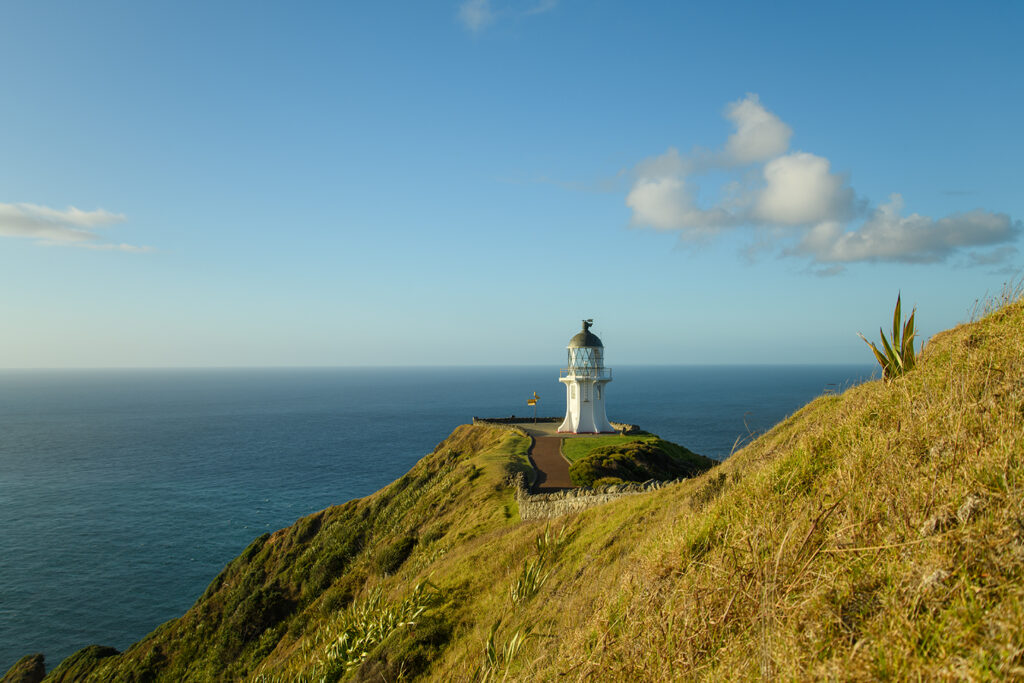
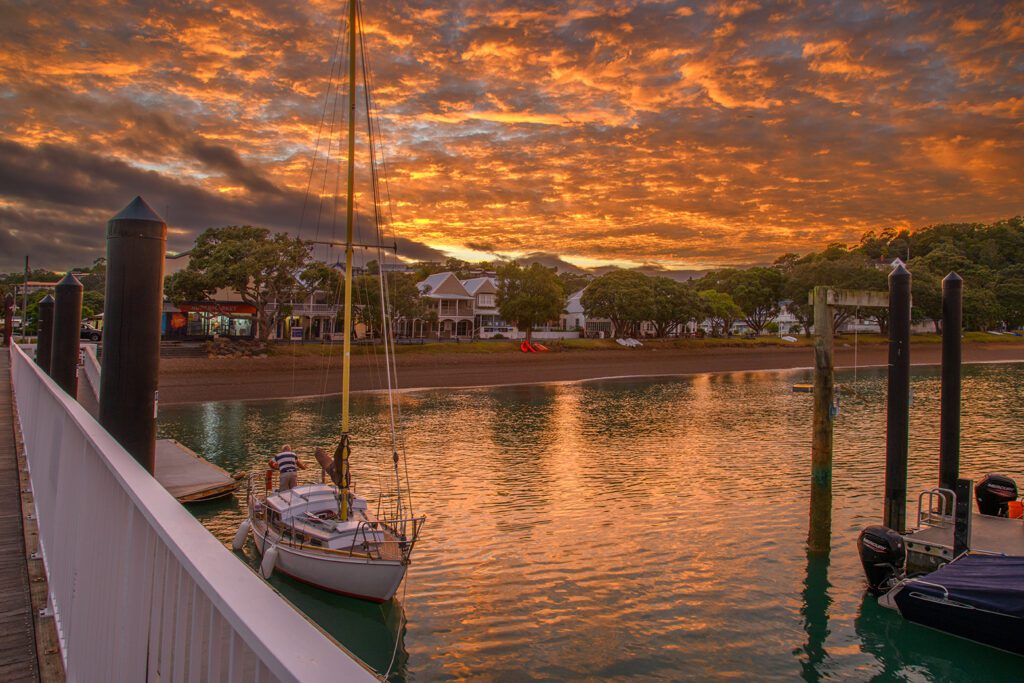
16. Bay of Islands
The historic resort town of Russel is located on the beautiful Bay of Islands and is popular with wealthy retirees. Here you almost get a bit of a South Sea feeling and are reminded of Lahaina on Maui in Hawaii. The landscapes are lovely, and you almost want to spend several days on holiday here.
© Christian Heeb

